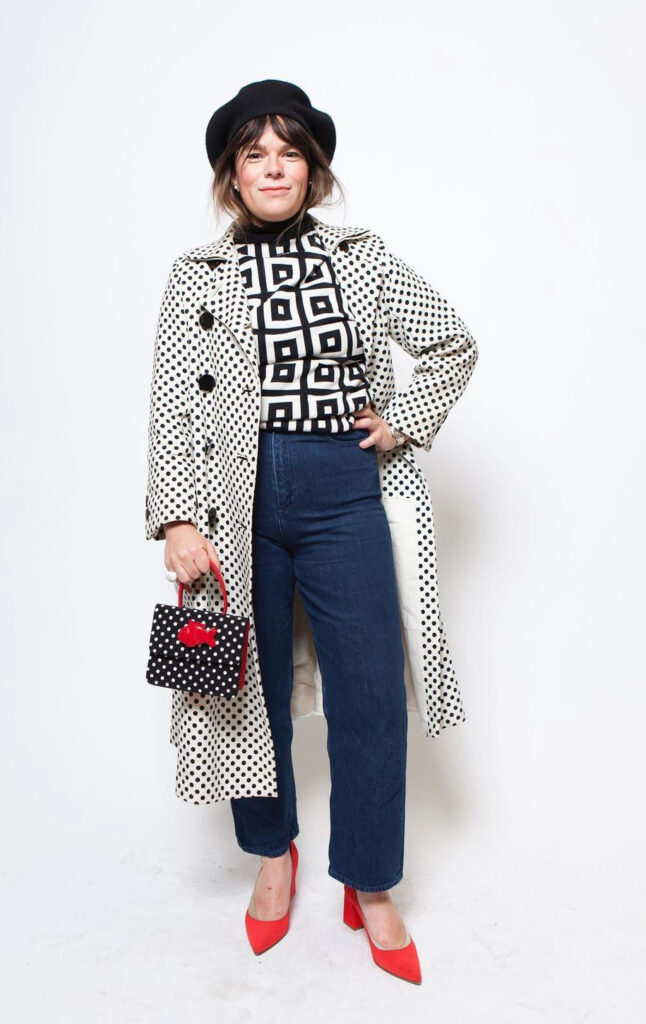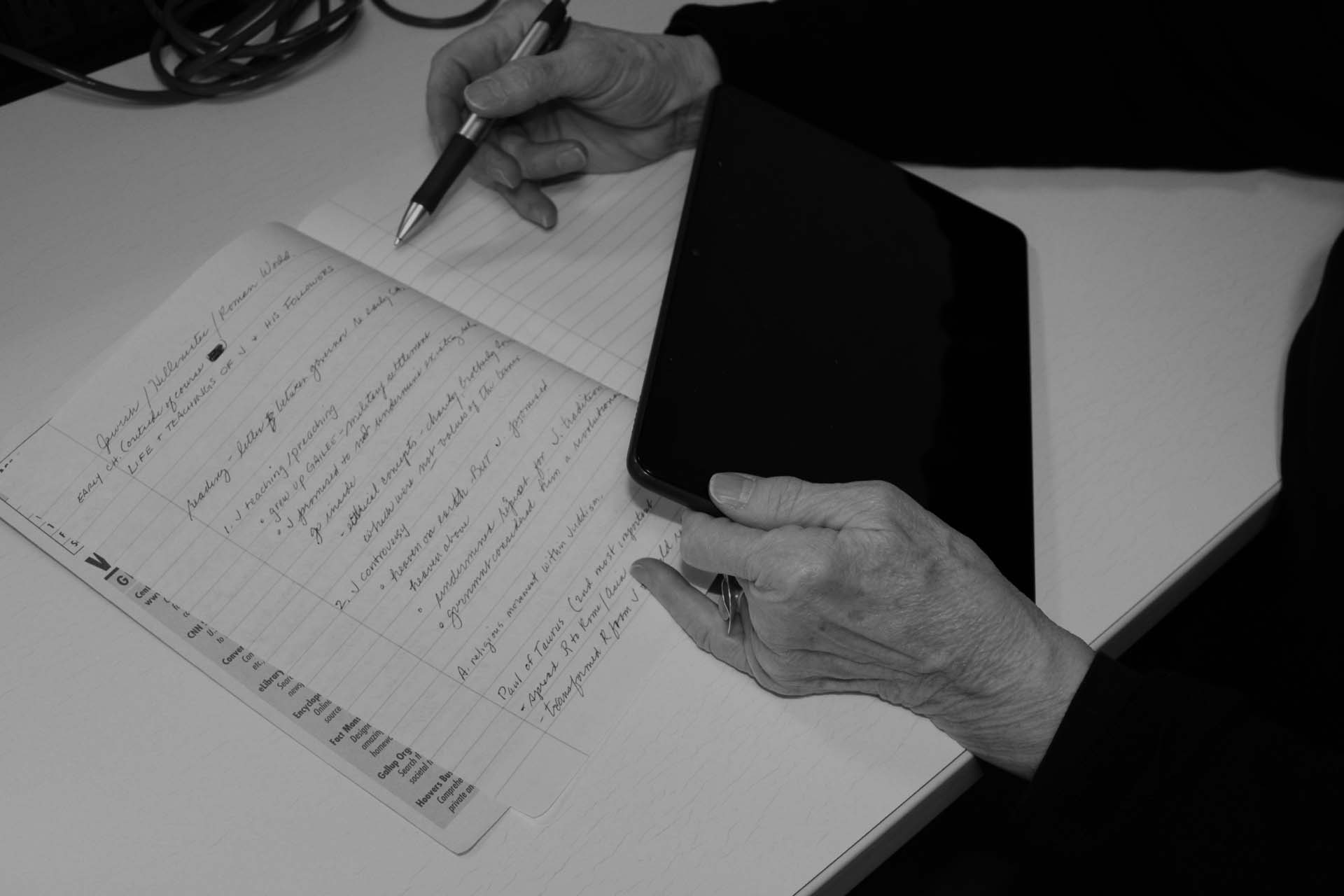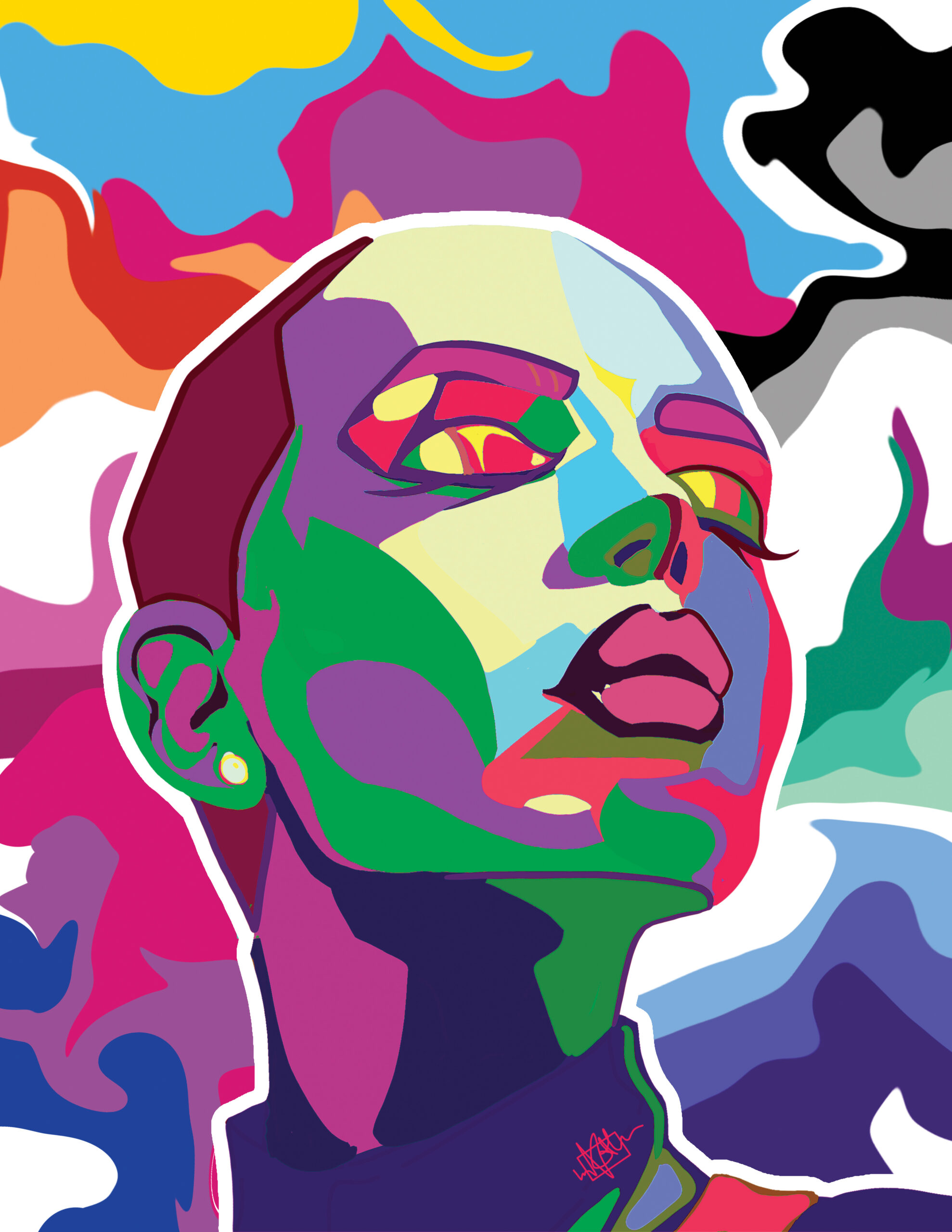
The Luxury Shrink
By Lily Ziaja
Photo courtesy of Rose Callahan
The Luxury Shrink brings a touch of whimsy & pops of color back to Minnesota

Meet Leslie Randall, designer, artist, stylist and fashion expert.
Originally from Wisconsin, Randall attended the University of Minnesota. Immediately upon graduating with a degree in apparel design, Randall moved to New York City. After almost a decade in New York designing embellishments, patterns and graphics for Kate Spade, Randall decided to relocate to St. Paul, Minnesota. In 2019, Randall established The Luxury Shrink, a one-stop shop for her curated services in artwork, branding and styling.
As she began to establish herself in St. Paul, Randall turned to her alma mater in hopes of sharing her experience in the fashion industry. This led to the 35-year-old fashion expert becoming a crucial member of the Design Board at the University of Minnesota.
This interview touches on creative inspiration, how fashion shapes us as individuals and the meaning behind staying true to ourselves.

Who are your favorite designers?
I am really into brands that are upcycling. I love Beaumarchais Paris, which is a department store that is so inspiring and they have a lot of brands I have never heard of before. Call It By Your Name was one of the stores I discovered there. Kujten is another favorite of mine for cashmere bandanas. La Veste also has great and cool funky items I love.
What is your strategy in dressing?
I love to wear printed pants. A lot of my tops are basic. It is a similar formula, it’s almost always a t-shirt, but then I’ll do either crazy pants or a crazy jacket. I go crazy for vintage jeans as well. I am also really into fabric, so I do not buy a lot of synthetic fabrics and that is something I have learned over the years.
What background do you have in fashion? What education do you think is necessary in determining vintage, styling and working with big brands?
I went to school for apparel design and am self-taught in graphic design. If your work speaks for itself, it doesn’t matter. Textile design is my favorite part of my business but my apparel design background makes me better at it because I understand how a print is going to go on the body in a way. I am also self-taught in vintage. Vintage is a lot like wine: the more you drink it, the more you know and the more you like it. It’s really empowering to be self-taught. If you love it, chances are it’s going to apply to something that you’re doing.
If you could live in any era of fashion what would it be/what is your favorite?
I would say early ‘60s. It was the perfect blend of funkiness but also this really cool exploration of silhouettes. The prints. The polka dots, florals and what they printed on silk. The ‘70s was when polyester became a thing. When you look at a silk print, it’s so vibrant in a way that polyester isn’t.
What is one fashion piece you simply cannot live without?
It would probably be my coats. Vintage coats specifically. There is an element of tailoring that’s really hard to replicate. The levels of tailoring and building inside the coat is incredible for vintage and the fabric development. The cool thing about vintage is a lot of times you’ll look and there are three different labels in a coat because there is a fabric mill. All the artisans come together to make something special, so I really geek over that.
What is your favorite piece in your collection?
I have my everyday piece that I cannot live without, which is my Jean-Charles de Castelbajac jacket. It is funny because I never would have thought it would be a staple piece for me. Sometimes you buy something that is not you and you just love it. I got it in New York and it is the most I have ever spent on a coat. I have worn it to death. It is my favorite. It is so versatile.
What do you think of microtrends and do you use them as inspiration at all?
Ultimately, I don’t pay a lot of attention to trends. I identify with a feeling or a lifestyle. Ralph Lauren is successful because it’s a lifestyle that doesn’t really adhere to trends for the most part. It is about a feeling. It’s not about the age demographic of an income. It is about telling the story of said lifestyle.
Do you have any tactics when styling someone? Questions you ask them, a way to catch their vibe, etc.
Honestly, I probably don’t ask enough questions but I think if I were to, I would ask about the parts of the person they enjoy accentuating and other parts they do not. I would ask the simple questions like “What do we have that you love?” and “What do we have that you’re not comfortable in?” Going off that, asking how much they want to play around. Some people just love to play dress up and others know exactly what they want. In terms of tactics, I don’t think people know how impactful accessories can be. Accessories make a look go to an editorial feel especially when you put on a pair of cool glasses.
Has fashion allowed you to form your identity as an individual?
When I started fashion I was taught it wasn’t about your identity, it was about your target market. When I moved to NYC, I started to explore my own identity and style. I got into vintage which is incredible because it’s better quality, more affordable and it’s one of a kind. I realized every fashion house uses vintage as inspiration because it is not replicable and it’s the best of the best.
I began to experiment and then I was inspired by Kate Spade and it ultimately dictated what I was into. Being in New York everything inspired me and I think I inspired other people as well. We are all feeding off that. Inspiration. The more I tried things on and thought about it and the concept of myself the more I gained a designer’s point of view.
Often we’re told it’s not about you, but when it’s your personal style, it’s always about you. If you do not have a strong sense of self, how can you really ever have an opinion on anything? I grew to know what I liked and then I would attract people who liked the same thing. I built a little community. To me that was the most successful part in figuring out who I was and my own identity in fashion.”
How do you think dressing differentiates you from everyone else? Do you have a specific story that made you stand out because of your style?
When you’re young, you don’t get to have an opinion in a lot of meetings and now that I am older, I understand that the more opinions you have in a room, the less you see a vision through. It is important to collaborate but I think oftentimes some of the best designs get watered down so that everybody can be happy.
In these meetings, as an entry-level designer, I did not get to talk but I wanted to show who I was for no other reason than I wanted to be remembered. I wanted to stand out and for others to know I was happy and excited to be there. So I would dress up in a point of view that I thought they would like but also that I really enjoyed. I was going to be strategic about what I was wearing so I wasn’t just the girl who brought the coffee in. If they liked my style, it would mean they would trust me more with what I was designing. If you show your point of view, you attract people who like it and fend off the people who do not.
When I got to Kate Spade, I didn’t even get a real desk, so I sat at a temporary one. This may seem negative but all of these important people would always walk by so I would get excited to dress up. One day, I was in a meeting with around 30 people, and Nicole, the creative director, stopped me and said, “Leslie, what jacket are you wearing?” I strategically wore this jacket because I knew it was special. I took it off and she was looking at it. The best part of this experience was that my boss was in the room and she was seeing that her boss not only knows my name but loves what I am wearing. They decided to send my jacket to Italy and have it made into the “Leslie Plaid.” People treated me differently from that day on. Not only did people start to look to me for ideas, they saw that I was a part of the vision that the creative director wanted to see.
What advice would you give someone wanting to enter the fashion industry?
The biggest thing is to stay true to yourself and your own identity. That is the most important, it is why you love it in the first place. You should love what you do and you should love who you do it with.
You should want to wear the stuff you make or even love it enough that you can see someone else wearing it. If you aren’t happy, you can change direction. If you aren’t paid enough, you can ask for a raise. Never lose sight of the fact that your standards are your standards and you don’t have to listen to them.
If you work too many hours, you deserve to not work too many hours. The worst thing you can do is try and normalize toxic environments in the fashion industry. This doesn’t mean you won’t have bad days because you will but I think we try to scare so many young people into just having to accept bad situations and I never agree with it. I think there is so much to be said about the fashion industry being toxic to us but it is what I am passionate about and it is what I love and that is what matters. We have fashion and we can be a part of what makes it better by not accepting bad standards.

What would you tell your 20-year-old self in regard to dressing and creative expression?
I think one, you’re way too hard on yourself. I worked so hard and still didn’t think I was good enough. I felt like I didn’t deserve to be there because I was from the Midwest. Looking back, I know I killed it. Your job is to worry about yourself first. Also, that my mistakes would be as important, if not more important as my successes. Ultimately, I wouldn’t change any of it.
What has been your favorite part about owning a business or the biggest challenge?
My favorite part is making my own rules. It didn’t happen overnight but getting to the point where you’re successful enough that you can say no to jobs that don’t align with your values or don’t pay enough is amazing. The hardest part would be not knowing month to month what I am going to make. Some months I can make a ton of money and other months are really quiet. It really varies.
What challenges and opportunities have you encountered in the fashion scene since relocating to St. Paul, Minnesota, and how has it influenced your approach to your work?
When I left New York, I thought I would fall off the face of the earth. Everything in fashion is there so I thought I wouldn’t get any work. It is totally not true. I can remotely work for a ton of different designers and somehow I happened to be working with way more people than I ever could have in New York. I am also able to slow down. The biggest challenge however is that I miss being inspired. I am just a dime a dozen in New York because someone is always wearing a crazier outfit. Here you don’t get that experience as much. They’re here but it’s nowhere near the level of unique and authentic style that is in New York.
The Luxury Shrink offers a range of services, including artwork, branding and styling. How do these elements intersect in your creative process, and how do they contribute to the overall identity of your brand?
When I am working with a brand, I am trying to authenticate their brand and strengthen their recognition. I am trying to help tell a story. My creative process is to make something beautiful. Bringing that lens in is crucial. All of it is visual, all of it is design-oriented and all of it is storytelling. I can kind of do it all the ways. I also do not look at it in a traditional way because of my experience. So I offer something unique at the Luxury Shrink. Some people do not enjoy it but there are plenty of people who are like, “I love and want your perspective.”

Collaborating with well-known brands like Kate Spade and Michael Kors, what have been the most memorable projects or experiences that have shaped your career at The Luxury Shrink?
I work with a company called Hunter Bell. That has become some of my favorite work. It started with them sending me prints and asking me to change the color. Now I own all of the print development. We also have a designer and she owns the designs and we all work together. When I am the only person talking to Spring, I can really let the ideas flow. It is so exciting. It takes a year from when I make it to see it but when I do, I am so proud.
What do you get out of the services you provide and the work that you do (what value do you get from it)?
I always like pushing my capabilities and what I can do. For example, I am using a lot of AI now to generate artwork. At first, I was like, I’m not a real artist then. This was such a weird way of thinking for me. AI is here to stay so now my stance is why not use it as an extension? Ultimately, we all have our perspective and no one can take that. I never like approaching anything with a scarcity mindset. You have to approach it out of love for yourself and someone’s idea. It’s also really important for me to do my own thing and create work simply for myself. I do it for myself and it’s really gratifying. I think it’s really important as a creative to have work that is just for you outside of everybody else’s thoughts, opinions and judgment.



